Do you think chin-ups are just a back workout? Think again.
Chin-ups are a powerful exercise that works many muscles, giving you a stronger upper-body workout than you’re expecting.
Understanding how a chin-up works different muscles can help you improve your exercise routine. It can also help you get the most out of your workouts and make them more interesting.
Read on to learn more about this classic exercise and why adding chin-ups to your routine helps to mass and strength.
It is time to give up the myth that chin-ups are all about the back and get ready to engage your entire upper body.
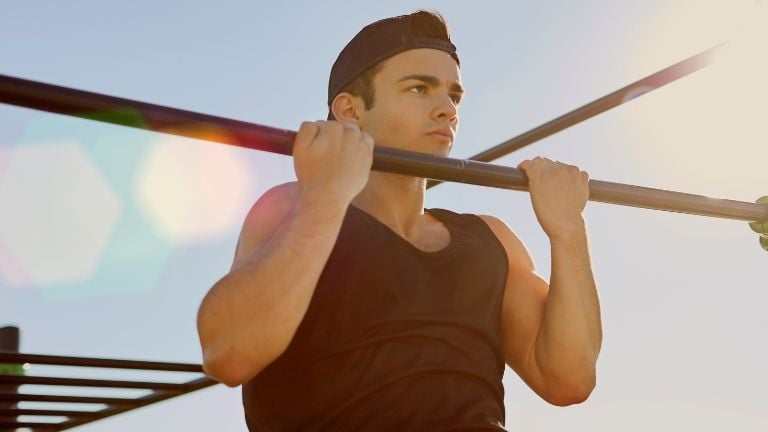
- What is Chin-Up
- 1. Grip
- 2. Muscle Worked
- 3. Difficulty
- Chin-Ups Muscles Worked
- Primary Muscles Worked in Chin-Ups
- 1. Latissimus Dorsi (Lats)
- 2. Biceps Brachii
- 3. Brachialis
- Secondary Muscles Worked in Chin-Ups
- 4. Brachioradialis
- 5. Trapezius
- 6. Rhomboids
- 7. Teres Major
- 8. Forearm Muscles
- 9. Core Muscles
- Science Behind Muscles Worked In Chin-Up
- How To Do Chin Up
- Variations and Modifications OF Chin-Ups
- Make It Easier
- Make It Harder
- 1. Machine Assisted Chin-Ups
- 2. Band-Assisted Chin-Ups
- 3. Isometric Holds Chin-Up
- 4. Weighted Chin Up
- 5. Negative Chin-Up
- 6. Single-Arm Chin-Up
- Benefits of Doing Chin-Ups?
- 1. Build Upper Body Strength
- 2. Improve Grip Strength
- 3. Improving Posture
- 4. Improving Shoulder Mobility
- 5. It Can Be Done Anywhere
- FAQs
- Are chin-ups good for building muscle?
- Can I do chin-ups every day?
- Do chin-ups work the core?
- Are chin-ups more effective?
- How many chin-ups a day?
- Do chin-ups build muscle fast?
- Do chin-ups give big arms?
- Takeaways
- References
What is Chin-Up
Chin-ups and pull-ups are among the best bodyweight exercises for the upper body, specifically the back muscles such as the latissimus dorsi, trapezius, rhomboids, shoulders, and arms.
Initially, chin-ups and pull-ups may appear similar, but there are actually some key differences between them. They are both performed using a pull-up bar; the main difference between the two exercises is the grip used.
1. Grip
- Chin-ups are performed with an underhand or supinated grip, with palms facing toward you.
- In pull-ups, you use an overhand (pronated) grip, with palms facing away from you.
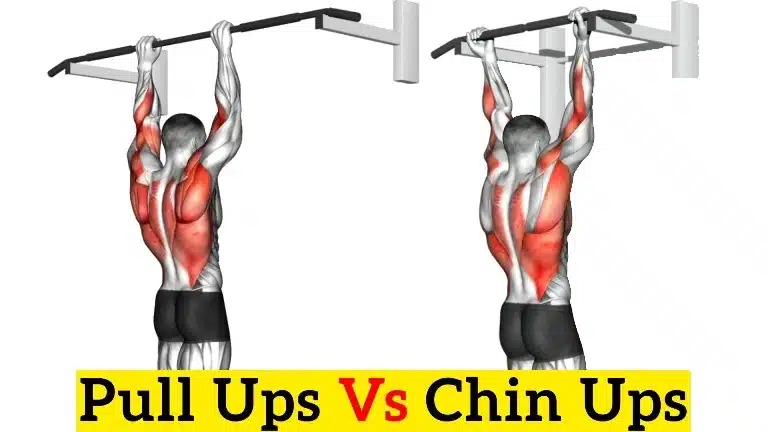
2. Muscle Worked
- Chin-ups emphasize the biceps brachii, brachialis, and brachioradialis more than pull-ups, but they still effectively train the lats.
- On the other hand, pull-ups focus more on the latissimus dorsi and less on the biceps. This grip targets the back and shoulders more than the biceps.
3. Difficulty
Many find chin-ups slightly easier than pull-ups due to the greater bicep engagement. If someone can do 8 pull-ups, they can usually do 12 chin-ups because they have different grips, muscles, and strength.
Know More: 25 Different Types Of Pull-Ups And Chin-Ups (Variations)
Chin-Ups Muscles Worked
Chin-ups primarily work the biceps but also involve several other muscle groups in the upper body.
- The main muscles that work during chin-ups are the biceps, brachialis, and latissimus dorsi.
- Other secondary and Synergist muscles worked during chin-ups are the brachioradialis, rear deltoid, rhomboids, Levator Scapulae, Trapezius muscle groups, pec major, erector spinae, teres major Infraspinatus, forearm muscles and core muscles (including rectus abdominis and obliques).
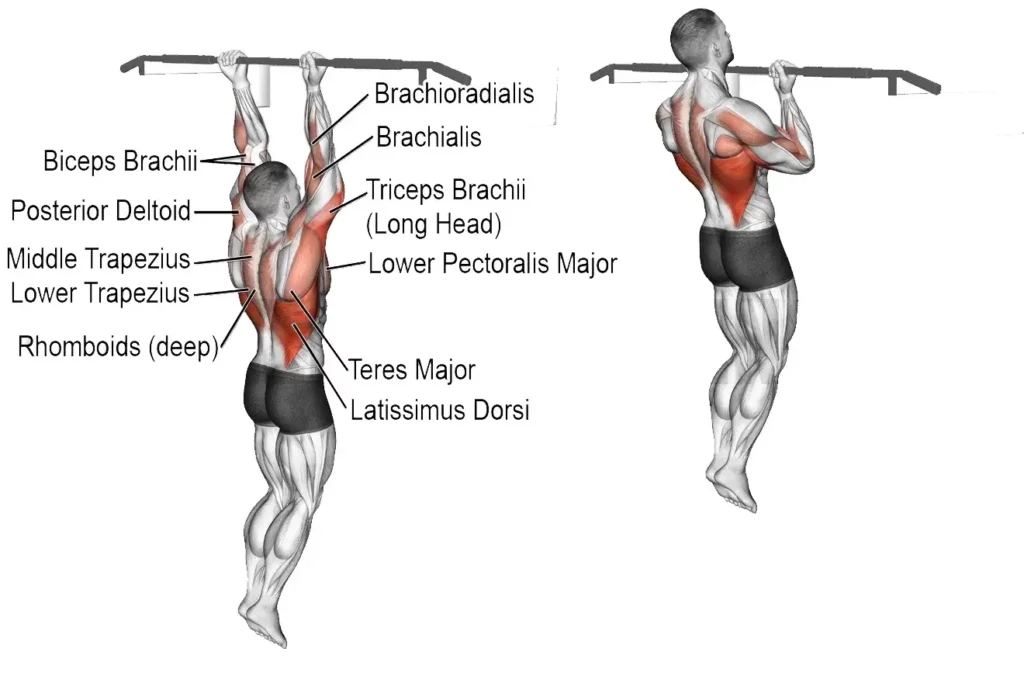
Primary Muscles Worked in Chin-Ups
The chin-up works several muscles in your upper body. The primary muscles used in a chin-up are listed below.
1. Latissimus Dorsi (Lats)
The latissimus dorsi muscles work prominently in most pull-up variations, but they are less emphasized during a chin-up because of the underhand grip. Nevertheless, the lats are still the muscle that works the most in the upper back during a chin-up.
When you pull your body towards the bar, your lats do most of the heavy lifting. The latissimus dorsi is a large, flat muscle on your back that plays a significant role in adducting and extending the shoulder joint.
2. Biceps Brachii
According to a 2018 study by the Journal of Physical Fitness, the bicep muscle is the second most active muscle during chin-ups.
The Biceps brachii is responsible for elbow flexion and forearm supination. It also helps you bend your elbow and rotate your forearm to turn your palm upwards.
When you pull yourself up, your biceps are one of the main muscle groups worked. When your biceps contract, they help bend your elbows and raise your body.
3. Brachialis
This muscle lies underneath the biceps brachii and is a strong elbow flexor. The brachialis is active during any elbow flexion activity.
During chin-ups, this muscle works with the biceps brachii to powerfully flex the elbow, aiding you as you lift your body.
Secondary Muscles Worked in Chin-Ups
While the primary muscles, like the latissimus dorsi, biceps brachii, and brachialis, do most of the work during chin-ups, some secondary muscles also help with the movement.
The muscles used during chin-ups are often overlooked but are important.
4. Brachioradialis
The brachioradialis muscle, which is in the forearm, aids in elbow flexion.
Even though this muscle isn’t the main focus of chin-ups, it helps the biceps and brachialis bend the elbow, especially when you’re pushing yourself over the bar.
5. Trapezius
The trapezius muscle helps stabilize the shoulders during a chin-up by retracting the scapulae (shoulder blades) and upwardly rotating them.
The trapezius muscle, also known as the trap, is one of the widest back muscles. It is divided into three parts: the upper, middle, and lower trap. All three parts contribute to shoulder stability.
6. Rhomboids
Located between your shoulder blades, rhomboids retract the scapula, bringing them towards the spine.
During the chin-up, as you pull yourself up and squeeze your shoulder blades together, the rhomboids are activated, aiding in scapular retraction.
7. Teres Major
This muscle is sometimes called the “little Lat” and works in conjunction with the latissimus dorsi to perform similar functions, such as adduction and arm extension.
While moving, the teres major assists the lats in pulling the humerus back and down, contributing to the lifting movement.
8. Forearm Muscles
Chin-ups require a strong grip on the bar, which stresses the forearm muscles a lot. Many people who struggle with chin-ups or pull-ups find that their weak forearms are the limiting factor.
9. Core Muscles
While not the main focus, the core muscles—including the rectus abdominis and obliques—are also engaged to stabilize your body during the chin-up.
Science Behind Muscles Worked In Chin-Up
The biomechanics and muscular engagement of chin-ups may appear straightforward, but they are based on intricate scientific principles.
Understanding the science behind which muscles are engaged during chin-ups can help you perfect your form and optimize your training regimen.
In one of the Study, electromyographic (EMG) activation of back, shoulder, arm, and abdominal musculature measured and expressed as a percentage of maximum voluntary isometric contraction (MVIC) during a pull-up, chin-up, or rotational exercise with Perfect Pull-up twisting handles.
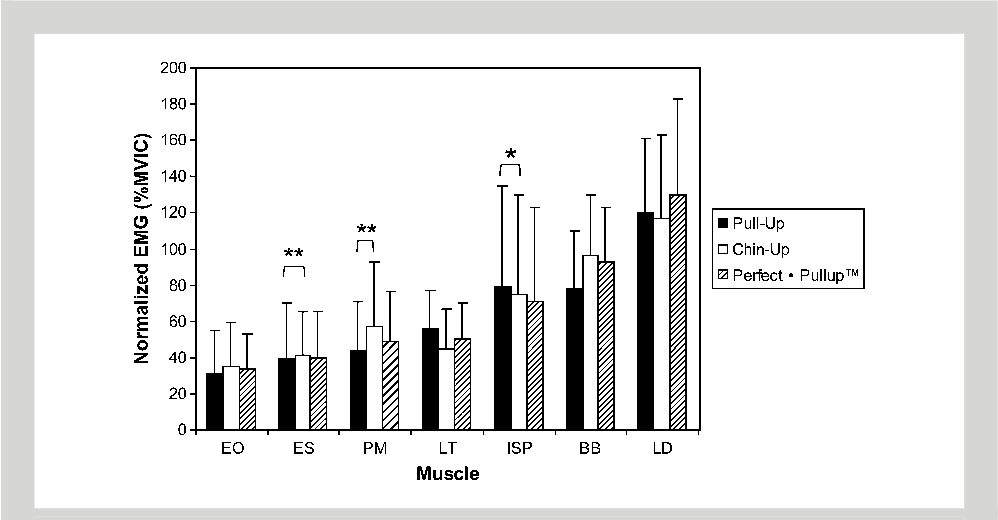
The muscles are:
- External oblique (EO)
- Erector spinae (ES)
- Pectoralis major (PM)
- Lower trapezius (LT)
- Infraspinatus (ISP)
- Biceps brachii (BB)
- Latissimus dorsi (LD)
Perfect PullupTM twisting handles were designed to rotate 360 upon a stationary base.
The Biceps brachii and pec major were more active during the chin-up than during the pull-up, while the back and lower traps were more active during the pull-up.
Note: In this study, the difference in muscle activation between chin-ups and pull-ups is surprisingly small.
Another useful paper for assessing the muscles worked in the chin-up and pull-up is the Electromyographic analysis of muscle activation during pull-up variations.
The study also shows that chin-ups build more muscle mass and are easier to progress with weight and load.
When done correctly, chin-ups allow for a greater range of motion because they allow the elbows to travel farther behind the back, resulting in a greater contraction.
Know More: 15 Best Bodyweight Back Workout: Beginner to Advanced
How To Do Chin Up
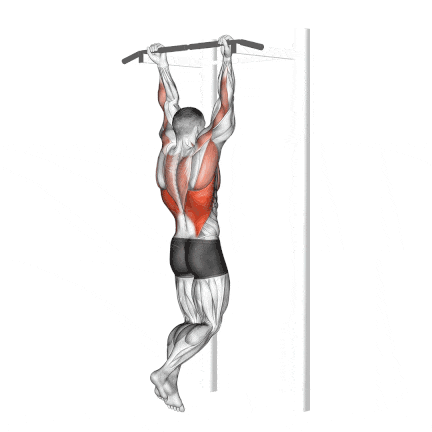
- Grip the pull-up bar with your palms facing toward you and use a narrow grip.
- Hang from the bar with your arms fully extended and shoulders pulled down and back.
- Engage your core and keep your body straight from your head to your heels.
- Pull your body up towards the bar by flexing your elbows and bringing your chest towards the bar.
- Keep your elbows close to your body as you pull yourself up.
- Once your chin is above the bar, hold for a moment and lower yourself slowly.
- Repeat for the desired number of reps.
Know More: Push Ups: Muscle Worked, How-To Do
Variations and Modifications OF Chin-Ups
When you want to try new workouts without adding gym equipment or training methods, you can combine a few types of chin-ups into one workout.
Many of these moves can be made easier or harder, depending on your requirements.
Make It Easier
There are ways to make chin-ups easier to do.
- Machine-assisted chin-up: where weight is added to assist with the movement.
- Resistance band-assisted chin-ups: where the band provides support and helps to lift a portion of the body weight
- Isometric holds: hold yourself in the top position of the pull-up or chin-up for a certain amount of time before progressing to full reps.
- You can step up to the pull-up bar using a box or bench, which reduces body weight being lifted.
Make It Harder
There are several modifications and variations that can be made to make chin-ups harder.
- Adding weight to the body, such as using a weight belt or holding a dumbbell between the legs.
- Chin up, with a wide grip, increases the difficulty and emphasizes forearms.
- Doing a one-arm chin-up, which increases the difficulty and emphasizes the upper body
- Incorporating dynamic movements such as plyometric chin-ups.
1. Machine Assisted Chin-Ups
Machine-assisted chin-ups are exercises that are performed using a machine that assists the user.
The machine allows the user to perform the exercise with less effort. Make it easier for them to complete a full range of motion.
This is especially helpful for beginners who need to build their strength gradually.

2. Band-Assisted Chin-Ups
Band-assisted chin-ups are a variation that uses a resistance band to assist in the exercise.
This variation can be helpful for beginners or those looking to increase the number of reps they can perform.
It can also be used as a way to progress towards unassisted chin-ups and pull-ups. The amount of assistance can be adjusted by using a band with different resistances or by adjusting the band’s position.
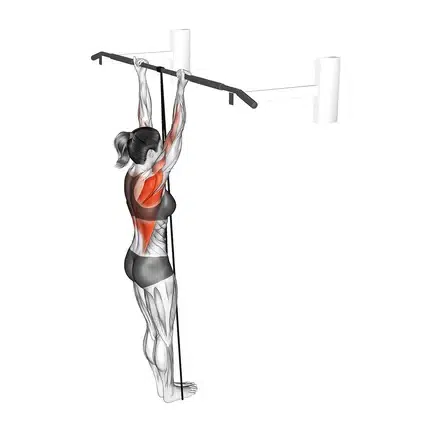
3. Isometric Holds Chin-Up
Isometric holds involve holding yourself at the top or both positions for some time.
This exercise can help build strength and endurance in the muscles used for pull-ups and chin-ups and improve overall technique.
For example, you can perform an isometric hold at the top of a chin-up by pulling yourself up to the bar and holding the position for a set period of time, such as 5–10 seconds.
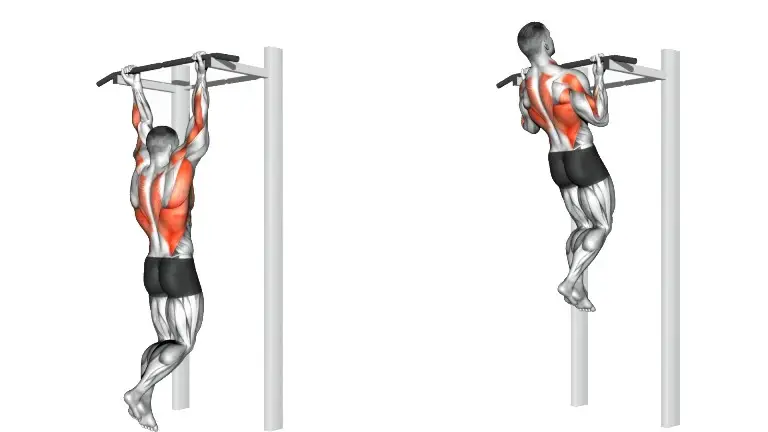
4. Weighted Chin Up
In weighted pull-ups and chin-ups, additional weight is added to the body during the pull-up, typically in the form of a weight belt or a dumbbell held between the legs.
The added weight increases the resistance and the difficulty of the exercise.
It’s a great way to progress from bodyweight pull-ups and chin-ups and to increase the intensity of the workout.
It’s also essential to have a strong base of bodyweight pull-ups before attempting this variation.

5. Negative Chin-Up
Negative Chin-ups, also known as eccentric chin-ups, focus on the eccentric (lowering) portion of the movement.
In this variation, you can use a step or a partner to help you jump or lift yourself to the top of the chin-up and then slowly lower yourself down over several seconds.
This can be a great way to increase muscle activation and strength in the upper back, lats, and biceps, as the eccentric portion of the movement typically places the muscle under the most tension.
Additionally, since the negative portion is slower, it creates more time under tension and can be more effective for muscle growth.
6. Single-Arm Chin-Up
A single-arm chin-up is a challenging variation of the traditional chin-up, which targets the same muscle groups but emphasizes grip strength and stability.
One-arm pull-ups and chin-ups are the best way to show your physical and mental strength.
Grips the bar with one hand and performs the chin-up movement with that arm.
This variation can help to increase muscle activation and strength in the upper body, particularly in the forearm, biceps, and back.
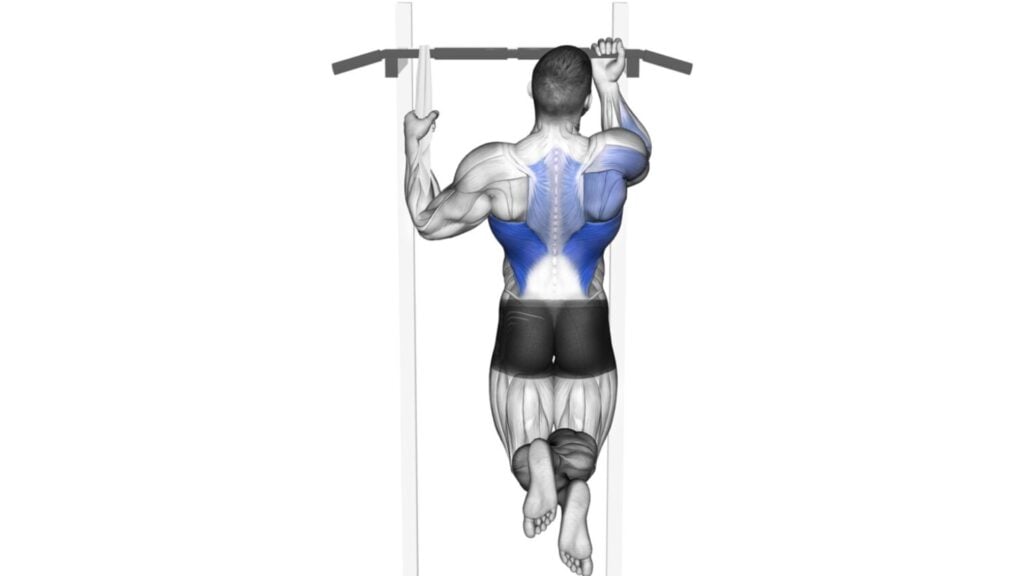
Benefits of Doing Chin-Ups?
Chin-ups provide greater activation of the arm muscles and back, which can be beneficial if you want to strengthen your upper body.
1. Build Upper Body Strength
Chin-ups engage multiple muscle groups simultaneously, including the latissimus dorsi, biceps brachii, brachialis, and secondary muscles.
This makes chin-ups an effective exercise for those looking to improve upper body strength and muscle definition.
2. Improve Grip Strength
The pulling motion used in chin-ups is a basic human movement pattern in many daily activities, such as lifting objects or climbing.
Regularly performing chin-ups helps improve grip strength, which can carry over to other exercises and activities.
3. Improving Posture
Chin-ups engage the muscles responsible for scapular retraction and depression, such as the lower trapezius and rhomboids.
It helps to strengthen the upper back muscles, improve posture, and reduce the risk of back pain.
4. Improving Shoulder Mobility
Chin-ups and pull-ups involve a good range of motion of the shoulder joint as you pull yourself up to the bar, which can help improve shoulder mobility.
5. It Can Be Done Anywhere
Chin-ups can be done with a pull-up bar installed at home, gym, or even in a playground, making it a convenient and accessible exercise.
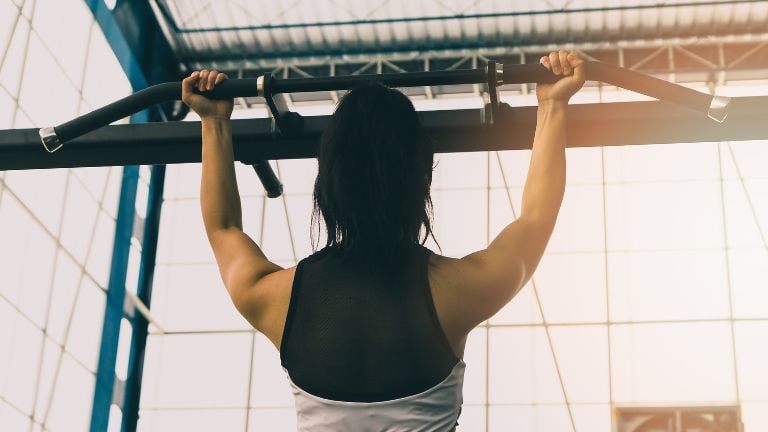
FAQs
Are chin-ups good for building muscle?
Yes, chin-ups are excellent for building muscle in the upper body, mainly when performed with proper form and technique.
Can I do chin-ups every day?
It’s best to let your muscles rest for at least 48 hours between intense chin-up workouts to avoid overuse injuries and to build muscle.
Do chin-ups work the core?
Yes, chin-ups do engage the core muscles to some extent. While the primary focus is on the upper body, your core stabilizes during the movement, providing a mild but beneficial core workout.
Are chin-ups more effective?
Compared to other exercises, chin-ups are highly effective for targeting multiple upper-body muscles like the lats and biceps.
Chin-ups are better for building bigger biceps, and pull-ups are better for building a wider back.
How many chin-ups a day?
The number of chin-ups you can do daily depends on your fitness level, how much rest you’re getting, and what other exercises you do. If you’re just starting, it is recommended to do 1-3 sets of 3-6 chin-ups every day, and gradually increase the number over time.
Do chin-ups build muscle fast?
Yes, chin-ups are effective for building muscle relatively quickly in the upper body, especially the lats and biceps, when incorporated into a balanced workout routine. However, the speed of muscle growth also depends on factors like nutrition, rest, and fitness level.
Finally, you need to give your muscles time to recover. This means taking rest days between workouts. When you work out, you break down your muscles. The rest days allow your muscles to repair themselves and grow stronger.
Do chin-ups give big arms?
Chin-ups are an effective exercise for building big and muscular arms. The exercise primarily targets the biceps brachii, brachialis, and brachioradialis. The narrow underhand grip of chin-ups elicits the most significant biceps activation, making it an essential part of your biceps training.
Takeaways
Chin-ups are effective exercises for building upper body strength and muscle mass. They are a compound exercise that works for several muscle groups simultaneously, including the lats, biceps, and shoulders.
In addition to building upper body strength and definition, chin-ups offer a range of benefits, including improving grip and core strength.
Chin-ups are a versatile exercise that can be done almost anywhere with a chin-up bar or a sturdy horizontal bar that can support your body weight.
References
- Hewit, Jennifer. (2018). A Comparison of Muscle Activation during the Pull-up and Three Alternative Pulling Exercises. Journal of Physical Fitness, Medicine & Treatment in Sports. 5. 10.19080/JPFMTS.2018.05.555669.
- James W Youdas Collier L Amundson, Kyle S Cicero, Justin J Hahn, David T Harezlak, John H Hollman: Surface electromyographic activation patterns and elbow joint motion during a pull-up, chin-up, or perfect-pullup™ rotational exercise. J Strength Cond Res 2010 Dec.
- Dickie JA, Faulkner JA, Barnes MJ, Lark SD. Electromyographic analysis of muscle activation during pull-up variations. J Electromyogr Kinesiol. 2017 Feb

Manish is a NASM-certified fitness and nutrition coach with over 10 years of experience in weight lifting and fat loss fitness coaching. He specializes in gym-based training and has a lot of knowledge about exercise, lifting technique, biomechanics, and more.
Through “Fit Life Regime,” he generously shares the insights he’s gained over a decade in the field. His goal is to equip others with the knowledge to start their own fitness journey.
